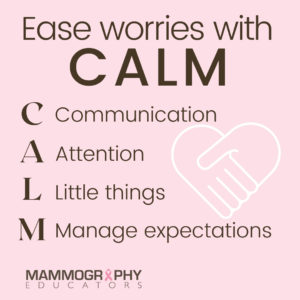Written by: Robyn Hadley, A.S., R.T.(R)(M)(ARRT), Mammography Educators Consultant
Fear and anxiety about mammography exams can manifest in a number of ways. Easing your patient’s anxiety during a mammogram can be difficult and sometimes feel impossible. How can we help ease our patient’s anxiety about their procedure? Alleviating patient apprehension can begin with C.A.L.M. What does C.A.L.M. look like?
C-Communication.
Simple, concise and effective communication is essential.
Actively listen when your patient is speaking. Stay attentive and focused on what the patient is saying while trying to view circumstances from their perspective.
Respond reflectively by restating what the patient said to assure your patient that they have been heard and understood. Respond with clear, concise and effective answers using verbiage that the patient will understand. Choose words that will encourage a positive atmosphere. For instance, instead of “pain”, use “discomfort” or “pressure”. Maintain attentive eye contact, use open body language with hand gestures and head nods.
Additionally, take note of your patient’s body language
and assess the nonverbal cues they may be expressing.
Facial expressions can indicate emotions such as anger, happiness, confusion, fear. Eyes can be referred to as the “windows to our souls”. Note if your patient is making direct eye contact indicating they are attentive and interested versus averting their gaze indicating they are distracted, uncomfortable and may be trying to conceal feelings.
A-Attention.
Give the patient your time and attention.

Minimizing distractions and multi-tasking can help maintain focus on your patient. This can be a challenging task given the life stressors occupying our thoughts on a daily basis.
To help technologists maintain focus and a perspective centered around the patient, pause before entering the exam room and take a deep breath.
As you knock prior to entering, imagine your hand placing a sticky note with all your stressors and to do lists on the door. Leave it all there outside the room and pick it up again when you are finished.
Begin with an introduction that will set the tone for a positive interaction. Introduce yourself by name and let her know you will be taking care of her.
Notice the patient’s pink tennis shoes she is wearing and tell her how much you admire them. It might just invite her to tell you that her daughter gave the shoes to her after she wore them for a charity run. This small conversation has the power to build trust through connection.
Recognizing that each patient is a unique and special person
is a key step in ensuring they feel respected and cared for.
L-Little Things.
At the heart of excellent patient experiences are the little things.
 It’s the small acts of kindness that make the interaction memorable. It costs us nothing and requires no new learning.
It’s the small acts of kindness that make the interaction memorable. It costs us nothing and requires no new learning.
Simply walking beside the patient while accompanying them to the exam room or taking a little extra time to listen to the woman who broke down in tears when she realized she forgot today was the anniversary of her husband’s death are the little things that can make a big difference.
For patients who are extremely worried about the results of their exam, try to expedite exam interpretation or provide them with a report before they leave, if possible. For the patient who told you she was going to plant flowers in her garden, draw a flower on her normal results letter. If you have a male patient, supply him with masculine magazines while he waits. Smile! We have all heard the saying, “everyone is going through something”. Each day, try to remember to do the little acts of kindness for your patients to help ease whatever struggles they might be facing.
We are human beings taking care of humans, being.
M-Manage Expectations.
Giving your patients an opportunity to express concerns and ask questions can make a difference.
Sometimes unpleasant circumstances are unavoidable BUT if individuals are informed ahead of time and kept up to date as situations may change, they are generally more accepting of delays, longer wait time, uncomfortable situations and stressful exams.
Explain the examination before you begin and communicate with the patient during the exam. Ask if there is anything you can do to make it easier for them. Once the exam is completed, describe how and when they will be notified of their exam results. Easing patient anxiety during screening mammography can seem daunting at times.

